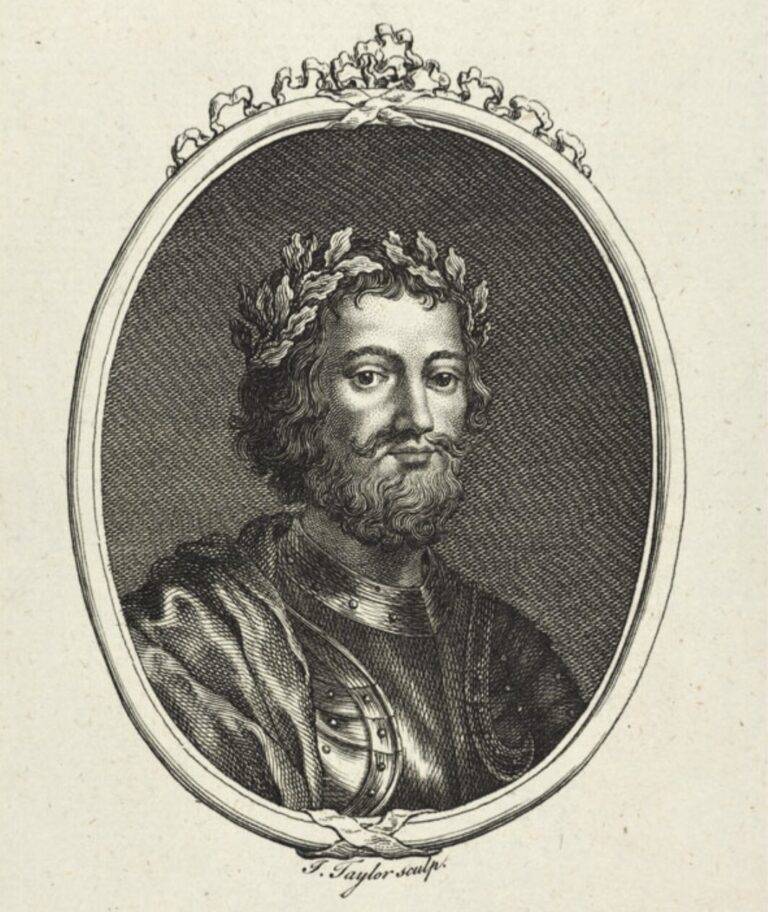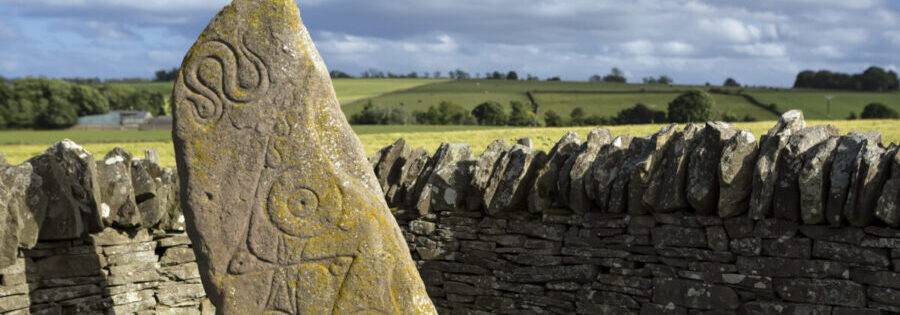
KENNETH MACALPIN : TARTAN VOL.4
January – 2024 10 MINS READ
According to the genealogy of the Scottish kings, Kenneth’s father was Alpín mac Echdach, the King of Dál Riada, which existed in what is now western Scotland. Alpín is considered to be the grandson of Áed Find, a descendant of Cenél nGabráin, who ruled in Dál Riada. The Synchronism of the Irish Kings lists Alpín among the kings of Scotland. Modern historians are sceptical about the reign of Alpín in Dál Riada and his relationship with Áed, and believe this misconception is the result of negligence on the part of the scribes in some texts. The genealogy of the kings of Scotland and Dál Riada dates back to an original manuscript that was written during the reign of Malcolm III in the mid-to-late 11th century. The Rawlinson B 502 manuscript provides the following ancestry for Kenneth:
…Cináed son of Alpín son of Eochaid son of Áed Find son of Domangart son of Domnall Brecc son of Eochaid Buide son of Áedán son of Gabrán son of Domangart son of Fergus Mór …
There is very limited information about Alpín, the father of Kenneth. Some of Dál Riada’s royal lists, which contain many scribal errors, say he ruled from 841 to 843. The Chronicle of Huntingdon, which was written in the late 13th century, states Alpín defeated the Picts at Galloway but the Picts then defeated him in a battle that took place in the same year, during which Alpín was killed. According to the chronicle, Alpín died on 20 July 834. This date is given in other sources but several researchers claim the date was probably copied from another source and the year of his death was obtained by recalculating the dates in the erroneous royal lists so they attribute Alpín’s date of death to 840, or 841.
Alpín’s mother is likely to have been a Pictish princess, the sister of Constantine I and Óengus II. According to the Pictish tradition, a female representative of the royal dynasty could inherit the crown. This origin gave Kenneth a legitimate claim to the Pictish throne.
Kenneth I had at least one brother, Donald I, who succeeded him as king.
Early Years: Kenneth MacAlpin was likely born around 810 in Iona, now part of Scotland. He became King of Dál Riada after his father’s death, around 840 or 841.
Conquest of Pictavia: Kenneth defeated the Picts in the second year of his reign and ruled there for 16 years. He was possibly the King of the Picts from 842 or 843 until his death in 858.
Geopolitical Challenges: In the 9th century, Dál Riada was mountainous and difficult to traverse. The Vikings were raiding its borders. This might have prompted Kenneth to attack the Picts.
Pictish Kings: After the death of Eóganan mac Óengusa, Uurad and then Bridei VI became Pictish kings. The Pictish kingdom fell around 849 or 850. Kenneth might have killed Pictish leaders during his conquest.
King of Alba: After annexing the Picts, Kenneth formed a new kingdom named Alba (later Scotland). He was the first King of Scotland in later records, but historians believe the final unification happened later.
Relocation and Assimilation: The Scots migrated to Pictish territories. Kenneth moved religious relics to Dunkeld and the Stone of Scone to Scone. The Scots assimilated the Picts without much resistance.
Military Actions: Kenneth invaded Lothian six times and faced attacks from Strathclyde and Vikings.
Royal Marriages: He arranged marriages for his daughters with kings of neighboring states.
Death and Succession: Kenneth died in 858, probably on February 13, in Forteviot. His brother Donald I succeeded him, followed by his sons. The Alpínid dynasty was established during this period.
Information about Alpín, Kenneth’s father, is sparse. Some royal lists from Dál Riada, known for scribal inaccuracies, suggest he reigned from 841 to 843. The 13th-century Chronicle of Huntingdon records that Alpín defeated the Picts in Galloway, but suffered defeat and death in the same year at their hands. This chronicle dates his death to 20 July 834, a date echoed in other sources, but some researchers argue this date is borrowed, and recalculations based on the flawed royal lists suggest 840 or 841 as the year of his death.
It is probable that Alpín’s mother was a Pictish princess, sister to Constantine I and Óengus II. In Pictish tradition, the crown could be inherited through a female member of the royal family, giving Kenneth a legitimate claim to the Pictish throne.
Kenneth I had at least one sibling, Donald I, who ascended the throne following him.
スコットランド王家の系図によると、ケネスの父はアルピン・マック・エハダックで、現在の西スコットランドに存在したダール・リアダの王であった。アルピンは、ダール・リアダで統治したケネル・ンガブラーンの子孫であるアエド・フィンドの孫とされている。アイルランドの王たちの同時代記には、アルピンがスコットランドの王の一人として記載されている。しかし、現代の歴史家たちは、アルピンがダール・リアダで統治したことやアエドとの関係に懐疑的であり、これらの誤解は一部の文献の写本家たちの過失によるものだと考えている。スコットランドとダール・リアダの王たちの系図は、11世紀中頃から後半にマルカム3世の治世中に書かれた原本に遡る。ローリンソンB502写本は、ケネスの祖先を以下のように記している。
…ケネスはアルピンの息子、アルピンはエハダックの息子、エハダックはアエド・フィンドの息子、アエド・フィンドはドマンガルトの息子、ドマンガルトはドムナル・ブレックの息子、ドムナル・ブレックはエオハイド・ブイデの息子、エオハイド・ブイデはアエダンの息子、アエダンはガブランの息子、ガブランはドマンガルトの息子、ドマンガルトはフェルグス・モールの息子…
ケネスの父アルピンに関する情報は非常に限られている。多くの写本の誤りを含むダール・リアダの王のリストによると、彼は841年から843年まで統治したとされている。13世紀後半に書かれたハンティンドン年代記は、アルピンがガロウェイでピクトを打ち負かしたが、同じ年に起こった戦いでピクトに敗れ、殺されたと記している。この年代記によれば、アルピンは834年7月20日に死亡した。他の資料でもこの日付が記されているが、いくつかの研究者はこの日付が別の資料からの写しであり、彼の死の年は誤りがある王のリストの日付を再計算して得られたもので、アルピンの死の年を840年、または841年と主張している。
アルピンの母は、おそらくピクト王族の姫君であり、コンスタンティン1世とオエングス2世の姉妹であった。ピクトの伝統では、王族の女性代表が王位を継承することができた。この出自はケネスにピクトの王位への正当な主張を与えた。ケネス1世には少なくとも一人の兄弟がおり、ドナルド1世で、彼がケネスの後を継いで王になった。
初期の年: ケネス・マカルピンは約810年にイオナ島で生まれたとされ、父の死後、ダール・リアダの王になりました。彼の即位は840または841年ごろです。
ピクトランドの征服: ケネスはピクト族を打ち破り、16年間統治しました。彼は842または843年から858年までピクトの王だった可能性があります。
地政学的な課題: 9世紀のダール・リアダは山がちで移動が困難でした。ヴァイキングの襲撃がありました。これがピクト攻撃の原因かもしれません。
ピクトの王: エオガナン・マック・オエングサの死後、ウラッドとブライディ6世がピクトの王になりました。ピクト王国は849または850年に滅びました。ケネスはピクトの指導者を殺害したかもしれません。
アルバの王: ピクトを併合後、ケネスは新しい王国アルバを形成しました(後にスコットランド)。彼は後の記録で最初のスコットランド王とされていますが、統一は後に起こったとされています。
移住と同化: スコット人はピクト地域へ移動しました。ケネスは宗教的な遺物をダンケルドへ、スクーンの石をスクーンへ移動しました。スコット人はピクト族を同化させました。
軍事行動: ケネスはロージアンを6回侵攻し、ストラスクライドとヴァイキングから攻撃を受けました。
王室の結婚: 彼は隣国の王たちと娘たちを結婚させました。
死と継承: ケネスは858年にフォーテヴィオットで死亡しました。彼の後を兄のドナルド1世が継ぎ、その後息子たちが継承しました。アルピン朝がこの時期に成立しました



